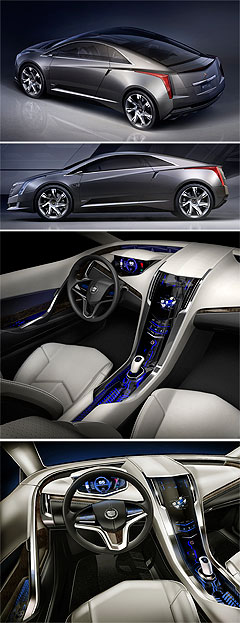Make / Model Search
Future models - Cadillac - ConverjDetroit show: Cadillac plugs in to VoltElectric dreams: The Cadillac Converj embraces GM's Voltec technology. General Motors shows off up-market hybrid concept12 Jan 2009 GENERAL Motors has presented a sports-luxury version of the Volt electric car wearing a Cadillac badge at the North American International Auto Show. It is the first time the plug-in hybrid powertrain – now described as Voltec – has appeared in a car other than the Volt, which is due to go on sale in the US late next year and in Australia in 2012. The new concept car revealed in Detroit is called the Converj and demonstrates GM’s intention to spread the new petrol-electric technology across its range of brands. GM global product development vice chairman Bob Lutz hinted there was a very real possibility the Converj will make it into showrooms, saying the car has "production substance". “It’s a logical extension of our plan to reinvent the automobile,” Mr Lutz said. “It clearly shows what a Cadillac electric vehicle could look like, and clearly indicates that global luxury customers can have a car that has both strong design and electric propulsion with a total range of hundreds of anxiety-free miles.”  The Converj sits on the same platform as the Volt, using the same combination of an electric motor and range-extending petrol engine. The Converj sits on the same platform as the Volt, using the same combination of an electric motor and range-extending petrol engine.As is the case with the Volt, the Converj uses a thermally managed T-shaped battery back that sits beneath the floor. It is made up of 220 lithium ion cells that store enough energy to propel the Converj for about 64km. When the battery runs low, the electronic management system switches to the range-extending petrol engine. GM provided few details of the range-extending engine in Detroit, other than pointing out it can run on up to 85 per cent ethanol. GoAuto understands the petrol engine is the same 1.0-litre four-cylinder used in the production version of the Volt. The Converj battery back can be recharged in eight hours using a 120V power outlet or in three hours using a 240V socket. The electric motor is capable of generating 120kW of power and 370Nm of torque for fast acceleration and has a top speed of around 160km/h. While it has a much more aggressive look than the Volt, the Converj has been shaped with aerodynamics in mind and as a result has minimal grille openings at the front of the vehicle to limit drag. The traditional wing mirrors have been replaced with tiny rearview cameras that display footage on an interior screen. A full underbody tray or belly pan and wheels that have been designed to push air outwards help with the airflow. The design of the Converj is similar in theme to the Cadillac CTS Coupe concept car, although it is not as long as that vehicle. It sits on massive 21-inch alloy wheels at the front and 22-inch rims at the rear. Cadillac has emphasised the performance potential of the Converj concept car by fitting it with magnetic ride adjustable suspension, a system usually reserved for its sportiest models. The Converj seats four people in a 2+2 arrangement. The concept car uses cutting-edge organic LED technology for its futuristic instrument display that can be configured to the driver’s preference. A touch-screen system controls the satellite navigation, climate control and audio systems. Read more:Detroit Show: Oz-bound Caddy SUVSydney show: Cadillac returns to Australia All motor show Alfa Romeo Alfa Romeo Abarth Abarth Alpine Alpine Alpina Alpina Audi Audi Aston Martin Aston Martin BMW BMW Bentley Bentley Chery Chery Brabham Brabham Chrysler Chrysler Chevrolet Chevrolet Cupra Cupra Citroen Citroen DS DS Dodge Dodge Fiat Fiat Ferrari Ferrari Foton Foton Ford Ford Great Wall Great Wall FPV FPV Haval Haval GWM GWM Honda Honda Holden Holden Hummer Hummer HSV HSV Infiniti Infiniti Hyundai Hyundai Jaguar Jaguar Isuzu Isuzu Kia Kia Jeep Jeep Land Rover Land Rover Lamborghini Lamborghini Lexus Lexus LDV LDV Mahindra Mahindra Lotus Lotus Mazda Mazda Maserati Maserati Mercedes-AMG Mercedes-AMG McLaren McLaren MG MG Mercedes-Benz Mercedes-Benz Mitsubishi Mitsubishi Mini Mini Opel Opel Nissan Nissan Peugeot Peugeot Pagani Pagani Proton Proton Porsche Porsche Renault Renault Ram Ram Rover Rover Rolls-Royce Rolls-Royce Skoda Skoda Saab Saab SsangYong SsangYong Smart Smart Suzuki Suzuki Subaru Subaru Toyota Toyota Tesla Tesla Volvo VolvoMotor industry news |
Click to shareAll motor show Alfa Romeo Alfa Romeo Abarth Abarth Alpine Alpine Alpina Alpina Audi Audi Aston Martin Aston Martin BMW BMW Bentley Bentley Chery Chery Brabham Brabham Chrysler Chrysler Chevrolet Chevrolet Cupra Cupra Citroen Citroen DS DS Dodge Dodge Fiat Fiat Ferrari Ferrari Foton Foton Ford Ford Great Wall Great Wall FPV FPV Haval Haval GWM GWM Honda Honda Holden Holden Hummer Hummer HSV HSV Infiniti Infiniti Hyundai Hyundai Jaguar Jaguar Isuzu Isuzu Kia Kia Jeep Jeep Land Rover Land Rover Lamborghini Lamborghini Lexus Lexus LDV LDV Mahindra Mahindra Lotus Lotus Mazda Mazda Maserati Maserati Mercedes-AMG Mercedes-AMG McLaren McLaren MG MG Mercedes-Benz Mercedes-Benz Mitsubishi Mitsubishi Mini Mini Opel Opel Nissan Nissan Peugeot Peugeot Pagani Pagani Proton Proton Porsche Porsche Renault Renault Ram Ram Rover Rover Rolls-Royce Rolls-Royce Skoda Skoda Saab Saab SsangYong SsangYong Smart Smart Suzuki Suzuki Subaru Subaru Toyota Toyota Tesla Tesla Volvo VolvoMotor industry news |









Facebook Twitter Instagram